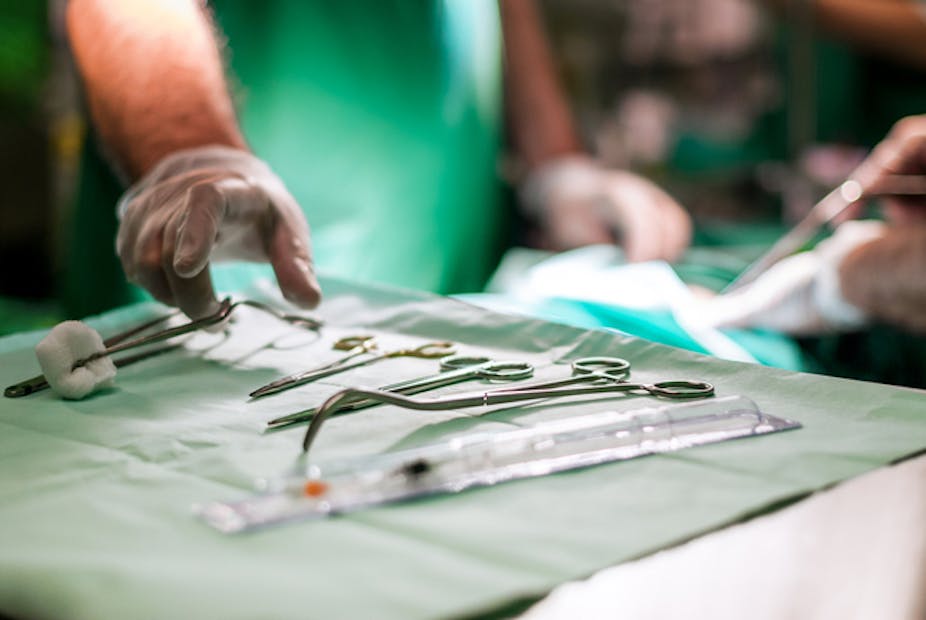Health care is a stressful and intrinsically risk-laden practice. Add to this the reality that all human beings are vulnerable to error and it’s inevitable that mistakes will be made. In 2012, there were 107 serious medical errors in Australian hospitals, ranging from surgery on the wrong patient or body part, and medication errors, to deaths or serious injuries associated with giving birth, and in-hospital suicides.
There’s no underestimating the effect of each of these mistakes – disability or death, and terrible loss for the families involved.
But system wide, there is some positive news. While there are annual variations in the number of serious errors, overall, serious adverse events decreased by 10% in the five years to 2012. Of the 53 million patient interactions nationwide each year the chance of a serious medical error occurring is incredibly low, at 0.000201%.
So, what have been the drivers of reform? And what progress is yet to be made in reducing medical errors?
Decade of reform
In 2003, following mounting international concerns about the rate and impact of health-care mistakes that could have been prevented, the World Health Organisation (WHO) passed a resolution supporting a strategic global agenda for achieving patient safety.
Over the past decade, health-care services have implemented robust surveillance and reporting systems to ensure errors are captured, the contributing factors are identified and analysed, and processes are put in place to prevent them from happening again.
Patients from OECD countries can now expect health-care providers to use evidence-based tools to reduce the risk of accidents, through the use of surgical checklists, and risk assessments for falls and developing pressure sores. And increasingly, they can expect their hospitals to use computerised drug prescribing, medical records, and clinical decision aids and support programs at the bedside.
Australia has been at the forefront of these initiatives, with the establishment of the Australian Commission on Safety and Quality in Health Care in 2006 prompting a range of initiatives. Importantly, the commission established an “open disclosure” framework, under which patients and their families are told immediately when something has gone wrong. Hospital staff must also inform them of what’s being done both to fix the problem and prevent it happening again.
This framework is accompanied by a national charter informing patients of their rights and responsibilities.

Simple tools, checklists and agreements have also made a big difference in reducing medical errors. When a patient is transferred from one care setting or context to another, health-care providers are encouraged to use tools to standardised approaches to clinical handover. And clinicians aim to agree, through consensus statements, on how they will recognise and respond to patients whose clinical condition is deteriorating.
To date, one of the commission’s most significant initiatives has been the development and publication in 2011 of ten national safety standards, which include strategies for patient identification and procedure matching (to reduce surgery being done on the wrong person or body part); preventing pressure injuries, falls and harm from falls; reducing the transmission of hospital-acquired infections; and improving medication safety.
The purpose of the standards is to provide a nationally consistent set of measures to improve the quality and safety of health-care provision and, ultimately, protect the public from harm. The standards must be met for Australian hospitals to achieve accreditation.
Sometimes, accidents happen
Despite improvements in hospital safety, preventable harmful events still occur. Clinical work is often carried out in situations that are largely unpredictable, so it’s inevitable that mistakes will be made.
It’s widely accepted in health care that we can’t fix what we don’t know about. The linchpin to improving patient safety continues to be having a robust surveillance and reporting system in place. Without a safe reporting system, mistakes will be driven underground and systemic problems might never be fixed.
Best practice tells us hospital management should make careful and non-punitive inquiries into what went wrong and why “the system failed” (errors are rarely the fault of individuals acting alone). They should also use the findings to inform improvements in the system in the hope that similar errors will not be repeated.
In the drive to improve the safety of health care, there has been increasing recognition that when things go wrong it’s not only the patient or family who suffers. Between 10% and 43% of health care professionals are also left the “second victims” after an event.

Health-care providers who have experienced the sickening realisation that they have made a bad mistake experience guilt, shame, psychological distress, and emotional burnout. Their personal and professional relationships can also be disrupted. Some may be so affected by the aftermath of the event that they feel unable to continue practising and may leave their profession altogether.
Safe reporting and error management has seen the emergence of a number of effective second victim coping strategies. These include: accepting responsibility when things go wrong, discussing the event with colleagues, disclosing what went wrong to the patient and apologising, analysing and evaluating the error, changing or improving the practice, and advocating for cultural change in the profession and organisation.
It’s also important to acknowledge that while things can go horribly wrong, they can also go incredibly right. This is due in no small part to human ingenuity and the now widespread recognition that patient safety is everybody’s responsibility – including patients and their families.

